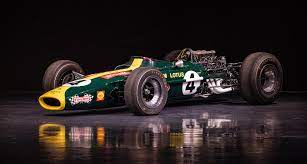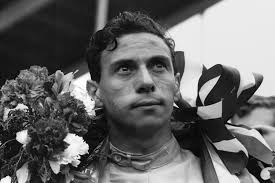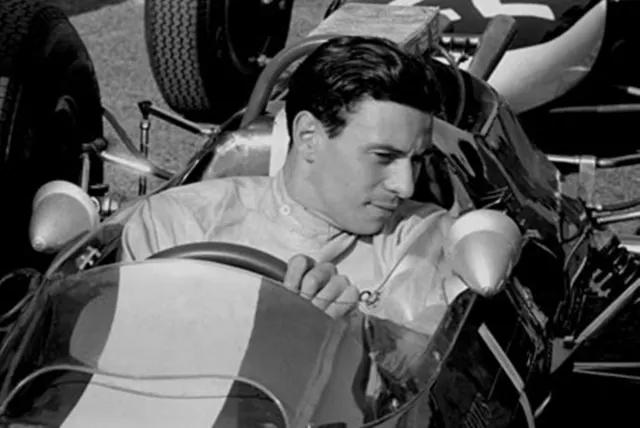Legendary Scottish driver, Jim Clark never intended to become a professional racing driver. He left school fully intent on joining his dad in their farming business. He raced purely as a hobby, and eventually Colin Chapman of lotus heard about him – the rest is history!
Jim Clark was a British Formula One racing driver from Scotland, who won two World Championships, in 1963 and 1965. He was also the first driver to win the Indianapolis 500 and the F1 title in the same year. He is widely regarded as one of the greatest racing drivers of all time.
In this article, we will explore his life and career, from his humble beginnings as a farmer’s son to his tragic death at the age of 32.
Jim Clark’s Childhood
Jim Clark was born on 4 March 1936 in Kilmany, Fife, Scotland, the youngest of five children and the only boy. His father was a sheep farmer who owned several farms in the Borders region.
Clark grew up in a rural environment, surrounded by animals and machinery. He developed a passion for cars and motorcycles at an early age and learned to drive on his father’s tractors and trucks.
Clark attended primary schools in Kilmany and Chirnside, and then went to boarding schools in Edinburgh and Musselburgh.
He was not particularly interested in academics, but excelled in sports, especially rugby and cricket. He also enjoyed playing the piano and singing in the choir.
Where Was Jim Clark Educated?
Clark received his secondary education at Loretto School in Musselburgh, East Lothian, where he was a prefect and a house captain.
He left school at the age of 18, without any formal qualifications, to join his father’s farming business.
He had no intention of pursuing a career in racing, but he was keen to participate in local road rallies and hill climbs as a hobby.
Jim Clark’s Family
Clark was very close to his family, especially his mother Helen, who supported his racing ambitions.
He had four sisters.
- Isobel
- Betty
- Helen
- Margaret.
He never married or had children of his own, but he had several girlfriends throughout his life, including Sally Stokes, who was with him when he died.
Clark was very loyal to his friends and colleagues, especially his mentor and team boss Colin Chapman, who gave him his first break in Formula One.
He also formed strong bonds with fellow drivers such as Graham Hill, Jackie Stewart and Dan Gurney.
How Did Jim Clark Get Into Motorsport?

Clark started his racing career in 1956, when he entered a local event at Crimond Airfield in Aberdeenshire, driving a DKW Sonderklasse that he borrowed from a friend.
He impressed the spectators with his speed and skill, despite having no formal training or experience.
Jim soon joined the Border Reivers team, run by Ian Scott-Watson, who became his lifelong friend and manager. He raced various cars, including Jaguar D-types and Porsches, in national events across Britain.
He won 18 races in 1958 alone.
His talent caught the attention of Colin Chapman, the founder of Lotus Cars and Team Lotus.
Chapman invited him to test one of his Formula Junior cars at Brands Hatch in late 1958. Clark finished second to Chapman himself in a ten-lap race.
Chapman was so impressed that he offered him a contract to drive for Team Lotus in Formula One.
How Did Jim Clark Get Into F1?

Clark made his Formula One debut at the 1960 Dutch Grand Prix at Zandvoort, driving a Lotus 18. He qualified fifth on the grid but retired on lap 42 with an engine failure.
Jim scored his first points at the next race in Belgium, finishing fifth.
He achieved his first podium finish at the 1961 French Grand Prix at Reims, where he came third behind Giancarlo Baghetti and Dan Gurney. He also set the fastest lap of the race.
Clark claimed his first victory at the 1962 Belgian Grand Prix at Spa-Francorchamps, where he dominated the race from pole position to chequered flag. He also won the British Grand Prix at Aintree that year.
Jim Clark Lotus

Clark became synonymous with Lotus Cars and Team Lotus during his F1 career. He drove various models of Lotus cars throughout his tenure with the team, including the Lotus 18, 21, 24, 25, 33, 43 and 49.
He won all of his 25 F1 races and both of his world titles with Lotus.
Jim also helped to develop and test new Lotus cars, such as the Lotus 38. He used the Lotus 38 to win the 1965 Indianapolis 500, and the Lotus 56, which he was supposed to drive at the 1968 Indy 500. Sadly he never did due to his death.
Clark had a close relationship with Colin Chapman, who regarded him as his protégé and friend. They shared a common vision of racing, based on innovation, speed and elegance.
They also trusted each other implicitly, despite the frequent mechanical failures and safety issues that plagued Lotus cars.
Jim Clark Lotus 49

The Lotus 49 was one of the most iconic and influential F1 cars of all time. It was designed by Colin Chapman and Maurice Philippe and introduced in 1967. The Lotus 49 was the first F1 car to feature the Ford Cosworth DFV engine, which became the dominant power unit in F1 for the next decade.
It was also the first F1 car to use aerodynamic wings, which increased downforce and grip.
Clark drove the Lotus 49 for the first time at the 1967 Dutch Grand Prix at Zandvoort, where he qualified on pole position and won the race. He also won the British Grand Prix at Silverstone and the
When Did Jim Clark Win the F1 World Championship?

Jim Clark won his first Formula One world championship in 1963, driving for Lotus. He dominated the season, winning seven out of ten races, and scoring a record 54 points out of a possible 60.
Clark also set a new record of seven pole positions in a season. He clinched the title with three races to spare, at the Italian Grand Prix at Monza.
Jim Clark’s second and final Formula One world championship came in 1965, again with Lotus. He won six out of ten races and scored 54 points out of a possible 60.
Jim became the first driver to win the Triple Crown of Motorsport, by winning the Indy 500 and the Tasman Series in addition to the F1 title.
He secured the championship with four races to spare, at the German Grand Prix at the Nürburgring.
Jim Clark’s Formula 1 Statistics
Jim Clark competed in Formula One from 1960 to 1968, driving exclusively for Lotus. He entered 73 races and started 72 of them. His statistics are listed below.
- He won 25 races, which is still the fourth-highest number of wins in F1 history.
- He also achieved 32 podiums
- 33 pole positions
- 28 fastest laps.
- He scored a total of 274 points (255 under the old scoring system).
- He had an average finishing position of 4.31
- He had an average starting position of 2.69.
- He led 1,943 laps out of a total of 4,898 laps he raced, which is a percentage of 39.66%.
Grand Tour Jim Clark Episode
The Grand Tour is a popular motoring show on Amazon Prime Video, hosted by Jeremy Clarkson, Richard Hammond, and James May.
In season three, episode five, titled ‘An Itchy Urus’, the trio paid tribute to Jim Clark by visiting his hometown of Duns in Scotland. They also drove some of his iconic cars on his favorite roads.
They also visited his grave and museum and met some of his friends and family.
Jim Clark Death

Jim Clark died on 7 April 1968, at the age of 32, in a Formula Two racing accident at Hockenheim in Germany.
He was driving a Lotus 48 when he went off the track at high speed and crashed into a tree.
The exact cause of the accident is still unknown, but it is believed that either a tire failure or a mechanical fault may have been responsible.
His death shocked the motorsport world, and led to calls for improved safety standards in racing.

